Hubert Munsey Martin

December 26, 1879 – April 29, 1965
Early History
Hubert Martin was born in Alexander County, North Carolina December 26, 1879. His parents were Samuel C. Martin and Rebecca Melvina Florentine Norton. His father died of typhoid fever when he was only about two years old, the same year Gatis, Hubert’s brother, was born. Hubert’s mother was married again to “Gas” (William Gaston?) Smith. She and her second husband had three girls and a boy, at least some of whom were born before they moved to Arkansas when Hubert and his brother, Gatis, were about 11 and 9 years old. They came as part of a big group from North Carolina, and lived in the Drasco/Wolf Bayou area in Cleburne County, Arkansas. In Arkansas at some point the Smith family moved back down on the river toward Wilburn. It was hard to get to their place – no roads much. The Martin boys were being treated badly by the stepfather and decided to run away or were chased away. Hubert never talked a great deal about this, but Gatis told his family that he, the stepfather, threw rocks at them to chase them off. We are not sure how old they were when they left, but were not yet adult, maybe 13 or 15 years old, so it must have taken considerable courage to leave their family. The Smith family stayed there where Hubert’s mother died of malaria and “Gas” Smith remarried after a time. Lorene said she and one of Gatis’s daughters visited Aunt Ola Outlaw, a Smith half sister of Hubert, long after Hubert was dead. Ola lived in Little Rock and was very friendly with the family. They had in mind trying to get more information about the relationship between Hubert and Gatis and the stepfather, but never managed to steer the conversation in that direction. We don’t know how they made the connection, but Hubert and Gatis ended up at the home of Fayette Ward at Wolf Bayou and Hubert at least, stayed with that family for several years. In the same Wolf Bayou community were their great uncle, Jacob Artimus Kever and three first cousins of their father. Perhaps they helped the boys find a place to live. Of course in the Ward household they were expected to work, but since the Wards had several children of their own, it would seem that they took them in out of kindness rather than for the work they could do. However, there was plenty of work to do, running a grist mill and a farm. It is interesting to think about the influences that caused Hubert to be the kind of man he ultimately became. Some of the reasons undoubtedly can be found in his innate temperament and intelligence. In his early life we can see some strong influences on Hubert – the abusiveness of his stepfather gave him a strong motivation to take a bold action. He took charge of his own life while he was still a child. The kindness and generosity of Mr. Ward in taking him in gave him a chance to live in and learn from a stable caring family. Also, during those years Hubert had the chance to go to school for the first time. We’re not sure how long he went to school – estimates vary from a few months to two years, but he made the most of it. If he hadn’t been given this opportunity, given his drive and intelligence, would he have found another way to become literate?
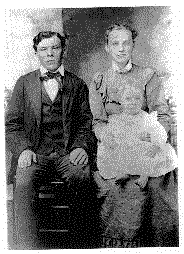 |
Among the students at the little one-room school at Wolf Bayou that he attended was his future bride, Maud Cranford, who had been going to school since she was about six years old. In those days a student did not necessarily spend a year at each grade. As soon as they could master the material at one grade they could go on to the next. Maud said that he “passed her up” very quickly. He was two years older than she was so he had an advantage in maturity. Probably he knew he wouldn’t be allowed to go to school for many years and looked at school as an opportunity, not an obligation or duty, so he was highly motivated to learn. During his whole life he had an interest in and respect for education. He read newspapers and other publications and kept himself well informed about local and world affairs. |
| Hubert and Maud Cranford were married on Thursday, January 12, 1899 at the home of L. T. Cranford, the bride’s parents, at Wolf Bayou, Arkansas by Rev. R. H. Grissett. We don’t know exactly where they lived at first, but the 1900 census lists their household as adjoining that of William and Ella Prichard, Maud’s sister’s family, and next to them the household of L. T. Cranford, Maud’s parents. Hubert continued to work at the Ward mill for several years. | 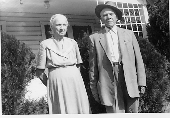 |
In the first week of December of 1899 another Norton family, Hubert’s uncle N.N.S.S. Norton made the move from North Carolina to Arkansas. The timing of this move was connected to the romantic situation of their daughter, Mary Edith. She was “in love” with a young man in North Carolina of whom the parents disapproved, so they made the move just before she would become 21 on December 27. It was said that the trip was like a “funeral train” because she was so upset at leaving her “love.” Family members, including Hubert, met their train and it was decided that Mary Edith would stay for a time with him and his very pregnant wife. She continued to stay with them until after the birth of their first child. She undoubtedly told them the news about the relatives who remained in North Carolina, including the fact that a little girl recently born there in the Norton family was named “Elva.” Perhaps that’s where they got the idea of the name for their baby.
Hubert and Maud’s second house was a log house, a portion of which still exists. A history of the house and a picture of it are on pages 50 and 51 of Louie Clark’s book, Wolf Bayou, Arkansas and Healing Springs Township. The house was built by Jacob Artimus Kever, great grandfather of Hubert Martin. Louie Clark describes the house as follows, “In a letter to his brother in North Carolina, Jacob A. Kever told how he had his new house almost finished. That he had hired John Barker to help install the floor. The letter is dated 1875. By this time his two oldest children had married.” “The house was one and a half stories made from hewed logs and dovetailed corners. A sleeping loft was in the upper half-story. Considering the tools of trade for that time, the house is constructed well. He also tells in his letter that he has three glass windows.” “This old house had been added to and taken away from so many times that the only original part was the log structure 20’x22′ with the original rock fireplace.” Louie’s daughter, Jeannie Clark McGary, had the log house moved to their home and restored.
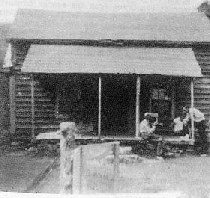
The Artimas Kever House circa 1930 |
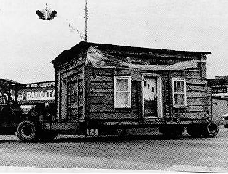
The house being relocated |
This is the house where Elva says she learned to crawl. Clee and Clyde were born in this house. Lorene says she heard stories of how Clee was afraid of the geese they had when they lived there – they chased him! About 1905 the Clark family in the Banner community left their place where they had a grist mill and some land in the area still known as the “Clark Bluffs.” For years this had been the center of things in this rural community. It was a crossroad for wagons, nestled at the foot of a row of bluffs, beside a stream large enough to power the mill. It had included a little general store in addition to the grist mill where people went to have their corn ground. There was no longer a store there by that time. Hubert acquired this place. Maybe he paid the Clarks informally, but there was no registered owner until he, Hubert, homesteaded it in 1915. Hubert and his family moved into a log house about a mile or so from the mill site on the Banner/Big Creek road. Lorene says the house consisted of a big room with undressed lumber walls. There was a partition across to divide the kitchen, with a fireplace at one end. The boys slept in the kitchen portion and the girls had a bedroom. Cloyse and Myrtle were born in that house.
The Mill Hubert spent all his time at the water wheel powered mill. As soon as the boys were big enough to help at all, they worked there too, as young as seven years old. He converted the mill so that it could be used to saw shingles. He would saw shingles during the week and grind corn on Saturdays. Clee says he used French burrs to grind the corn, and that he often took a toll for pay. With his growing family, I’m sure they made good use of the corn meal tolls. Clee tells a story that happened in those years. He and some other boys were playing around the mill. In order to operate the mill, Berry branch had been diverted so that it could fall onto the water wheel from above. A board could be inserted or removed to cause the water to either be diverted around the wheel to stop it or to fall on it to start the wheel turning. Of course on Sundays the wheel was not operating, but one of the boys, Fant Dye, decided it would be exciting to place himself inside the wheel and let his “friends” release the water to make the wheel spin – (thereby making his version of a Ferris wheel?) This plan was carried out, but there was a slight problem – they couldn’t stop the water from turning the wheel, and so had to run to the house and get Clee’s father, Hubert. He went as fast as he could and stopped it. Fant was not physically hurt, but I imagine he might have had a few nightmares as a result of this episode! Hubert was a strict parent and could be a harsh disciplinarian, but Clee does not remember any punishment in this case. Probably he knew they were so scared he didn’t have to worry about them repeating this mistake. Hubert was so busy with the mill that he didn’t have the time or interest in doing many other tasks about the place. Elva and Lorene both told about their mother’s frustration that he would not keep the garden fence in repair so “range” animals would sometimes get into the garden and destroy it. Maud was given the responsibility of the garden. Perhaps he or a son would plow it now and then, but for the most part she raised the gardens to feed all those hungry mouths. Elva told of one time he went to look at the garden with Maud. The rows of plants were growing OK, but were not planted in a very straight row, so he made the “constructive criticism” of saying, “If you would just put a stake at each end of the row and tie a string between them, you could plant them in a straight row.” I’m not sure how she replied, but I can well imagine what she felt like saying! Since they were seriously outgrowing the log house, and Hubert had no time to build a house, he got his brother, Gatis to build a new house for them in 1911. I’m not sure how long Gatis had stayed with the Wards, probably not as long as Hubert. He learned to be a carpenter and for years built many of the houses in the area. He got some “on-the-job carpenter training” when he went to Galveston, Texas with some other men from the community to make money helping to rebuild the area after a disaster. In looking at an Almanac, my guess is that it might have been after a hurricane that occurred in August of 1900. The storm was followed by tides that inundated Galveston causing an estimated 6,000 deaths. The original house Gatis built for his brother had a large fireplace room big enough for a bed or two, a large kitchen with room for a big table for dining; a bed could be fitted in there too, a bedroom downstairs big enough for two beds. From this bedroom there was a stairway up to a finished room upstairs. This upstairs room was the site of another enterprise of Hubert’s, a photography studio! He walled off a corner of the room and used it to develop pictures. He had a camera with accordion folds and a tripod. He had a stamp, “Martin Gallery.” I don’t know how many customers he had but we have some pictures he made that I think are quite good. My favorite is a picture of my mother, Elva, when she was 17 years old. She is standing in the garden gate and is holding an opened black parasol held behind her so that it frames her face. This shows that he knew something about “composing” the picture and arranging an appropriate background. Elva’s future husband, Earl Stuart, carried a copy of this picture in his wallet when he was in France in World War I. When I asked several people how they remembered Hubert Martin, they invariably said “quiet, steady, hard-working, industrious, dependable, honest, good manager.” Clelan mentioned “patriotic;” he wanted politicians to do right for the country. He was enthusiastic about 4th of July picnic celebrations at Banner. Lorene surprised me by saying “sociable”, “loved public life.” Of course all of those words described some aspect of him. Lorene tells of the time he came in, having caught “the biggest fish I ever saw.” Clelan says it was a 60 pound catfish, that they had to hang it from a cedar tree to skin it. When he brought it home he invited in all the neighbors to help eat it.
Technology Pioneer Clelan remembers that he was often the first one to try something new. Examples are car, radio, electricity using a Delco generator, gasoline powered washing machine, kerosene refrigerator. He says he rode in a plane when people in that area had not even seen many. I’m not sure when that was, but I remember in the late 30’s we would go outside and look up when a plane came over – it was that unusual a novelty to see one. Maud, on the other hand, discouraged new things. Here’s one dialogue as Clelan remembers it: She, “Why did you buy a wall clock? We don’t need it. Why did you spend money for it?” He, “Well, I only paid a dime for it.” He also liked sales, bargains!
The First Automobile Hubert bought one of the first cars in the area, but his children agree that he was never a very good driver. I don’t suppose this had anything to do with it, but his “driver training class” left something to be desired. He bought his first car in Batesville. The dealer gave him a demonstration while driving up Brock Mountain. At the top of the mountain, the dealer left and Hubert was on his own. He had not mastered shifting gears. Clee and Cleston were terribly excited about the car and wanted to ride at every opportunity. The car travelled so slowly in low gear that Clee would complain that he could get off and run faster than the car would go. “Can’t this car go any faster, Dad?” Hubert indicated the pedals at his feet and expressed a view that it had something to do with them, but he didn’t know what.
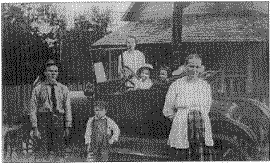
One day the car broke down on the way to the sawmill and they all left it and walked on to work. During the course of the day a man drove up in his own car. There was a discussion concerning the broken down car and the man said he’d take a look at it. He cleaned the spark plugs and got it started and then, to the joy of the boys, shifted the car into higher gears and achieved greater speed. Pure magic!! Needless to say, the boys did not need to be shown a second time.
People in that time and place had to do for themselves – there were not many “experts” available to help with urgent problems. Sometimes the problems were medical. One day Clelan was playing around the mill or working there when he had a good sized sliver of wood driven through his hand and wrist from the underside of the palm through the two bones and out the top side of his wrist. His dad came around right away. He got out his pocket knife and cut off one end of the sliver and then yanked it back out the other way to remove it from Clelan’s hand and wrist. Clelan still has the scar but suffered no handicap from the injury. They did later take him to the doctor, but with no antibiotics it is doubtful that he added anything of much value to the treatment. Clyde tells of an example that, to me, show how his children respected and cared for him. In the 1920’s many of the single young men in the community were leaving to go to St. Louis to get work and bring in considerably more cash income than they could get at home. Some ended up permanently staying there or elsewhere, and some saved up some money and returned to their home area. Clyde was seeing his friends make this move and do well financially, and he was tempted to do likewise, but he felt that he was essential to his Dad’s lumbering operation – that he was the best worker he had. He was the “fireman”, feeding the fire under the boiler with pine slabs. He was the only person who could do it efficiently enough to keep the saw running with no down time. They never discussed this, but it was obviously the situation. I don’t believe Clyde was paid for this work other than a place to live, clothes, etc., so he certainly did not stay because of a monetary advantage, but he did stay until he was about 21 years old. Finally, he decided that he must take this opportunity to make some money for himself, so he approached his Dad. Hubert did not try to dissuade him but gave him $15. I doubt that their conversation was a very long one, but each had a respect and appreciation for the other. By the way, that $15 was a pretty good investment. A one-way train ticket from Newport to St. Louis cost $10.64 and another $ .25 to take the “bull moose” train from Batesville to Newport. That left Clyde with $4.11, but it was all he needed to start a very successful business career.
Lorene says her dad loved singing. He couldn’t sing well, but he tried, and was an active participant in “singings” which he enjoyed, not just for the music but for the social interaction involved in it. One singing tradition that lasted until the 1940’s was the 4th Sunday in June singing (“all day singing with dinner on the ground”) which started at Mt. Zion Baptist Church but moved to the Concord school when it was built about 1930. Many times churches would “go dead” in the winter when it was hard for people to get out in the bad weather, then there would be brush arbor revivals in the summer to get them started again. Hubert had been a Methodist and for many years that denomination was not in the community. There had been a Methodist church at Mt. Etna but it did not last too long. For a time there was a Union Church held in the school building (no denomination) and Hubert was secretary of the Sunday School.
Hubert’s ancestry was partly German, and sometimes we have a stereotypical view of Germans as holding their feelings inside. For the most part Hubert fit that stereotype. Lorene says he never hugged them, never showed emotion but in spite of that she knew absolutely that he loved her.
| His children were pretty much afraid of him. He had a “short fuse” and expected them to behave, and certainly to obey the first time they were told. There are still many mysteries about raising children and we often don’t know the “right” way to handle every situation, but one can’t argue with the fact that Hubert and Maud raised eleven children under very difficult circumstances and they all turned out to be good, stable adults of whom any parent would be proud. Maybe his discipline was harsh by today’s standards, but he also managed to communicate to them that he loved and cared about them. | 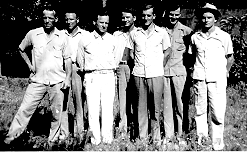 |
He was very interested in the school system and served on the Board of Education for many years. Maybe because he had so little chance to go to school it seemed especially precious to him. His formal education was brief, but it served him well. He was the Justice of Peace for the community and had some law books which he consulted as needed. I guess nobody told him that a person with two years of school shouldn’t be able to read and understand law books! He could look at a stack of lumber and make a mental calculation of the number of board feet it contained that would be quite close to the actual measurement. (A board foot is the equivalent of a board that is one inch thick, a foot wide, and a foot long.)
Hubert was open to new ideas and eager to make improvements in the community. Probably in the 1930’s some government entity decried that there would be a tick irradication program. The ticks had become really thick due to open range for all cattle. Dipping vats were built at various places so that all farmers would have access to them. The farmers were then ordered to dip all their cattle. There was resistance to this order. Clee, Cleston and Cloyce thought it was a feeling of resistance to interference from the government in their daily lives and that they also resisted because it required considerable work and effort to round up your own cattle off the open range and herd them to the dipping vat that may be on someone else’s property, and dip them. There were “enforcers” for compliance with the law. Feelings ran so wild that one “enforcer” was shot and killed, presumably a “bushwhacking” and the killers never found. One night the dipping vat built on Hubert’s place was blown up – dynamited! Both Clee and Cleston remember being awakened by the blast. They ran to the vat and they remember the fluid with insecticide dripping from the tree limbs. The vat was destroyed, but later rebuilt. In recent years Clelan and Cleston Martin and Charles Stuart found it, still intact, though covered with plant growth. The vat was about two to three feet wide and about four feet deep. The cattle were run through the vat and at the exit there was a concrete ramp called the “drip-pan” which the cattle would stand in until the insecticide dripped off and ran back into the vat. The tick irradication program did seem to be very successful according to Clee Martin. There were a lot less ticks following the program. Later the boys found another use for the dipping vat. They would fill it with clear water from the spring and learn to swim. The narrow sides made it easy to grab on and get a breath if you needed it!
Lorene says that after Hubert died, people looked at his business records which he had kept for himself over the years, and it was quite impressive the way he had kept accurate records of everything. Sometimes his payment had come in the form of goods instead of cash but it was all recorded. The lumber business prospered. As new technology came along he upgraded the equipment. He would buy the timber from tracks of land and saw it. He got a planer and could sell dressed lumber. In the years just before World War II he got contracts to sell all the lumber he could produce, ran several trucks and employed quite a few people (in addition to all those sons – 8 in all.) Around the beginning of World War II the shortage of machinery parts and available labor forced him to close down the sawmill. The older sons had families of their own and work of their own. Three of his sons were drafted into the military, Clelan, Raymond, and Hoyle. Cleston and Claren who were already married and had children worked in defense plants in Memphis.
| In 1941 or 1942 Hubert and Maud built a new house on some land they owned in Concord on Highway 25. It had electricity, indoor plumbing with the running water pumped from a well in the basement with an electric motor. He had a good sized pond built near a spring below the house. I believe he stocked it with fish, and also he and others swam in it.I don’t know how he learned to swim so well, but I remember as a child that the extended Martin family would have picnics on White River and one of the highlights for the grandchildren was to ride on Grandpa’s back while he swam with us. It was fun and exciting. It was not until I learned to swim myself much later that I realized how difficult it was to carry another person while you swim – even a child! | 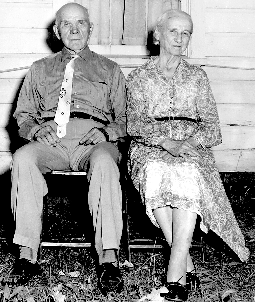 |
He was a doting grandfather. If he ever even scolded me, I don’t remember it. We lived within sight of their house for much of my childhood. We, and several other neighbor children, had to wait for the school bus outside their house. If the weather was bad we would troop into their fireplace room and wait for the bus by the fire, probably tracking in mud or snow much of the time. If they criticized us it must not have been done harshly, because I don’t remember it. On Christmas soon after we had opened our presents from Santa, we would go to their house for the get together with all the aunts, uncles and cousins. The first thing all the grandchildren were shown was the footprint Santa had left in the ashes as he came down the chimney. He explained that he had made the fire around it so we could see it – proof positive that there was a Santa! My older brother’s statement that there was no Santa, that he was our parents, made absolutely no sense in view of Grandpa’s incontrovertible proof that he came down the chimney and left his track in the ashes. He grew peanuts and saved huge bags and boxes of them especially for the grandchildren. His enjoyment of grandchildren continued all his life. After he was no longer in the lumber business he got interested in raising a vegetable garden. Finally I guess he could “plant the rows straight” as he had urged Maud to do much earlier. The difference was that he didn’t also have to do the cooking, washing, sewing, quilt-making for a large family, so had the time to make fantastic gardens. He devised a system for irrigation when there was not enough rain. He produced far more food than the two of them needed and gave it away freely. Finally, Maud’s health started to break and she gradually became unable to do even household tasks. He learned to cook! One of the last times I was at their house he had made a sweet potato cobbler that was delicious. Several times I have remembered that and tried to make one – with a result that was barely edible.
Maud was put in a nursing home in Heber Springs when she could no longer be cared for at home. Hubert could no longer drive safely, so he would ride almost every day with his son, Cloyse, who carried the mail, to Heber Springs to visit Maud. He continued to tend his garden and cook and take care of himself. One day he was found dead at home lying across the bed in the bedroom by the back door. The garden looked freshly worked and his hoe was leaning up by the back door, so it is assumed that he had chest pain while he was doing work that he enjoyed, came in, lay down and died. Most of us would have trouble improving on that method of leaving this world. When you think of all the skills Hubert acquired in his life, understanding machinery, reading, running a business, community leader, photographer, gardening, cooking, to name some of them, I think that indicates he had a great “zest for life.” Right up to the end of his life, his eyes and ears were wide open to learn something new and to participate in everything that went on around him.
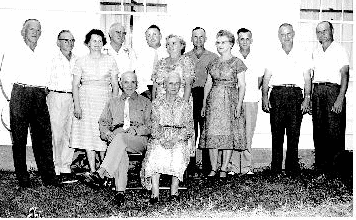 |
|
The Hubert Martin Family circa 1960 |
|
Seated: Hubert and Maud Martin Left to right: Clee, Clyde, Lorene, Cloyse, Cleston, Myrtle, Clarion, Elva, Clellan, Raymond, Hoyle |
From “Martin Family Stories” by Cleta Stuart Porterfield Sources for the information given, in addition to my memory, include: Written notes by my mother, Elva Martin Stuart, Conversations with Hubert and Maud’s children, A newspaper article about their 50th wedding anniversary, Obituaries, Anecdotes written by my brother, Charles Stuart, after hearing them from Hubert and Maud’s children. Norton family information from Ava Sutherland Baker

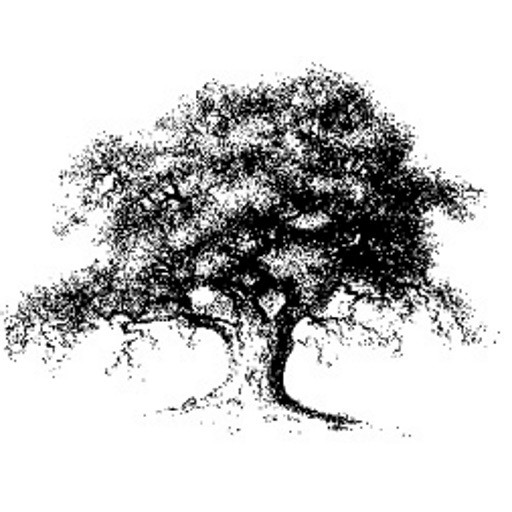
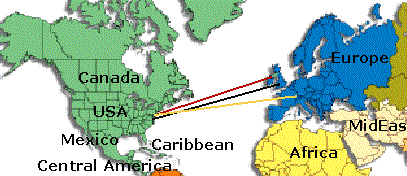


So enjoy you hard work.
Thanks
Dawn MARTIN Rudisill